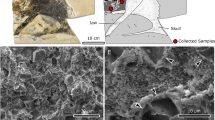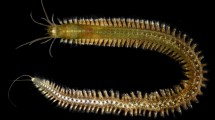Abstract
The morphologies of eumelanin, isolated from the six cephalopods species Sepia esculenta, Sepia lycidas, Sepia pharaonis, Sepiella japonica, Euprymna berryi, and Uroteuthis (Photololigo) edulis, were investigated using atomic force microscopy (AFM). The results showed that the hierarchical aggregate structures of irregular spherical particles with different diameters are the common characteristics of these eumelanins. Furthermore, the diameters of these spherical particles present an uneven distribution in a wide range and mainly concentrate in the range of about 20-150 nm. In addition, the eumelanin from different cephalopods species show obvious differences in the morphologies, which is illustrated by different assembly forms of diverse aggregate units and the quantitative features of eumelanin particles derived from the images.
Similar content being viewed by others
References
Abbas, M., D’Amico, F., Morresi, L., Pinto, N., Ficcadenti, M., Natali, R., Ottaviano, L., Passacantando, M., Cuccioloni, M., Angeletti, M., and Gunnella, R., 2009. Structural, electrical, electronic and optical properties of melanin films. European Physical Journal E, 28: 285–291.
Alarfaj, N. A., Abdalla, M. A. E., and Alawiya, M., Al-Hamza, A. M., 2012. A sensitive electrogenerated chemiluminescence assay for determination of melanin in natural and biological samples. International Journal of Electrochemical Science, 7: 7888–7901.
Araújo, M., Viveiros, R., Correia, T. R., Correia, I. J., Bonifcio, V. D. B., Casimiro, T., and Ana, A. R., 2014. Natural melanin: A potential pH-responsive drug release device. International Journal of Pharmaceutics, 469: 140–145.
Bloisi, F., Pezzella, A., Barra, M., Alfè, M., Chiarella, F., Cassinese, A., and Vicari, L., 2011. Effect of substrate temperature on MAPLE deposition of synthetic eumelanin films. Applied Physics A, 105: 619–627.
Centeno, S. A., and Shamir, J., 2008. Surface enhanced Raman scattering (SERS) and FTIR characterization of the sepia melanin pigment used in works of art. Journal of Molecular Structure, 873: 149–159.
Chiarelli-Neto, O., Ferreira, A. S., Martins, W. K., Pavani, C., Severino, D., Faiao-Flores, F., Maria-Engler, S. S., Aliprandini, E., Martinez, G. R., Mascio, P. D., Medeiros, M. H. G., and Baptista, M. S., 2014. Melanin photosensitization and the effect of visible light on epithelial cells. Plos One, 9 (11): e113266.
Clancy, C. M. R., and Simon, J. D., 2001. Ultrastructural organization of eumelanin from Sepia officinalis measured by atomic force microscopy. Biochemistry, 40: 13353–13360.
Clancy, C. M. R., Nofsinger, J. B., Hanks, R. K., and Simon, J. D., 2000. A hierarchical self-assembly of eumelanin. Journal of Physical Chemistry B, 104: 7871–7873.
Derby, C. D., 2007. Escape by inking and secreting: Marine molluscs avoid predators through a rich array of chemicals and mechanisms. Biology Bulletin, 213: 274–289.
Derby, C. D., 2014. Cephalopod ink: Production, chemistry, functions and applications. Marine Drugs, 12: 2700–2730.
El-Obeid, A., Al-Harbi, S., Al-Jomah, N., and Hassib, A., 2006. Herbal melanin modulates tumor necrosis factor alpha (TNF-a), interleukin 6 (IL-6) and vascular endothelial growth factor (VEGF) production. Phytomedicine, 13 (5): 324–333.
Gilmore, J. L., Yoshida, A., Takahashi, H., Deguchi, K., Kobori, T., Louvet, E., Kumeta, M., Yoshimura, S. H., and Takeyasu, K., 2015. Analyses of nuclear proteins and nucleic acid structures using atomic force microscopy. Nuclear Bodies and Noncoding Rnas Methods in Molecular Biology, 1262: 119–153.
Hong, L., Garguilo, J., Anzaldi, L., Edwards, G. S., Nemanich, R. J., and Simon, J. D., 2006. Age-dependent photoionization thresholds of melanosomes and lipofuscin isolated from human retinal pigment epithelium cells. Photochemistry and Photobiology, 82: 1475–1481.
Hunt, G., Kyne, S., Ito, S., Wakamatsu, K., Todd, C., and Thody, A., 1995. Eumelanin and phaeomelanin contents of human epidermis and cultured melanocytes. Journal of Pigment Cell Research, 8: 202–208.
Ito, S., 1986. Reexamination of the structure of eumelanin. Biochimica et Biophysica Acta-General Subjects, 883: 155–161.
Jastrzebska, M., Mroz, I., Barwinski, B., Wrzalik, R., and Boryczka, S., 2010. AFM investigations of self-assembled dopa-melanin nano-aggregates. Journal of Materials Science, 45: 5302–5308.
Lei, M., Wang, J. F., Wang, Y. M., Pang, L., Wang, Y., Xu, W., and Xue, C. H., 2007. Study of the radio-protective effect of cuttlefish ink on hemopoietic injury. Asia Pacific Journal of Clinical Nutrition, 16: 239–243.
Liu, Y., and Simon, J. D., 2003. The effect of preparation procedures on the morphology of melanin from the ink sac of Sepia officinalis. Pigment Cell Research, 16: 72–80.
Liu, Y., and Simon, J. D., 2005. Metal-ion interactions and the structural organization of Sepia eumelanin. Pigment Cell Research, 18: 42–48.
Liu, Y., Hong, L., Wakamatsu, K., Ito, S., Adhyaru, B. B., Cheng, C. Y., Bowers C. R., and Simon, J. D., 2005. Comparisons of the structural and chemical properties of melanosomes isolated from retinal pigment epithelium, iris and choroid of newborn and mature bovine eyes. Photochemistry and Photobiology, 81: 510–516.
Liu, Y. C., Chen, S. M., Liu, J. H., Hsu, H. W., Lin, H. Y., and Chen, S. Y., 2015. Mechanical and photo-fragmentation processes for nanonization of melanin to improve its efficacy in protecting cells from reactive oxygen species stress. Journal of Applied Physics, 117: 064701, DOI: 10.1063/1.4907997.
Matsuura, T., Hino, M., Akutagawa, S. I., Shimoyama, Y., Kobayashi, T., Taya, Y., and Ueno, T., 2009. Optical and paramangnetic properties of size-controlled ink particles isolated from Sepia officinalis. Bioscience Biotechnology Biochemisty, 73 (12): 2790–2792.
McQueenie, R., Sutter, J., Karolin, J., and Birch, D. J. S., 2012. Eumelanin fibrils. Journal of Biomedical Optics, 17 (7): 075001.
Mohanraju, R., Marri, D. B., Karthick, P., Narayana, S., Murthy, K., and Ramesh, C., 2013. Antibacterial activity of certain cephalopods from andamans, india. International Journal of Pharmaceutics Biology Science, 3: 450–455.
Nasti, T. H., and Timares, L., 2015. MC1R, Eumelanin and pheomelanin: Their role in determining the susceptibility to skin cancer. Photochemistry and Photobiology, 91: 188–200.
Novellino, L., Napolitano, A., and Prota, G., 2000. Isolation and characterization of mammalian eumelanins from hair and irides. Biochimica et Biophysica Acta (BBA) -General Subjects, 1475: 295–306.
Ozeki, H., Wakamatsu, K., Ito, S., and Ishiguro, I., 1997. Chemical characterization of eumelanins with special emphasis on 5,6-dihydroxyindole-2-carboxylic acid content and molecular size. Analytical Biochemistry, 248: 149–157.
Peles, D. N., Hong, L., Hu, D. N., Ito, R., Nemanlch, R. J., and Slmon, J. D., 2009. Human iridal stroma melanosomes of varying pheomelanin contents possess a commom eumelanic outer surface. Journal of Physical Chemistry, 113: 11346–11351.
Perna, G., Lasalvia, M., D’Antonio, P., Mallardi, A., Palazzo, G., Fiocco, D., Gallone, A., Cicero, R., and Capozzi, V., 2014. Morphology of synthetic DOPA-eumelanin deposited on glass and mica substrates: An atomic force microscopy Investigation. Micron, 64: 28–33.
Peroni-Okita, F. H. G., Gunning, A. P., Kirby, A., Simã o, R. A., Soares, C. A., and Cordenunsi, B. R., 2015. Visualization of internal structure of banana starch granule through AFM. Carbohydrate Polymers, 128: 32–40.
Tang, J., Jiang, C. R., Xiao, X., Fang, Z. H., Li, L., Han, L. H., Mei, A. Q., Feng, Y., Guo, Y. B., Li, H. Y., and Jiang, W. Y., 2015. Changes in red blood cell membrane structure in G6PD deficiency: An atomic force microscopy study. Clinica Chimica Acta, 444: 264–270.
Tinker-Mill, C., Mayes, J., Allosp, D., and Kolosov, O. V., 2014. Ultrasonic force microscopy for nanomechanical characterization of early and late-stage amyloid-beta peptide aggregation. Scientific Reports, 4: 1–7.
Tsukamoto, K., Palumbo, A., D’Ischia, M., Hearing, V. J., and Prota, G., 1992. 5,6-dihydroxyindole-2-carboxylic acid is incorporated in mammalian melanin. Biochemical Journal, 286: 491–495.
Wünsche, J., Cicoira, F., Graeff, C. F. O., and Santato, C., 2013. Eumelanin thin films: Solution-processing, growth, and charge transport properties. Journal of Materials Chemistry B, 1: 3836–3842.
Yoshikawa, N., Matsuda, T., Takahashi, A., and Tagawa, M., 2013. Developmental changes in melanophores and their asymmetrical responsiveness to melanin-concentrating hormone during metamorphosis in barfin flounder (Verasper moseri). General and Comparative Endocrinology, 194: 118–123.
Zeise, L., Murr, B. L., and Chedekel, M. R., 1992. Melanin standard method: Particle description. Pigment Cell Research, 5 (3): 132–142.
Zhang, W., Sun, Y. L., and Chen, D. H., 2014. Effects of chitin and sepia ink hybrid hemostatic sponge on the blood parameters of mice. Marine Drugs, 12: 2269–2281.
Zheng, G. L., Zhang, X. Y., Zhou, Y. G., Meng, Q. C., and Gong, W. G., 2002. Comparison between partial components and trace elements in sepia and squid ink. Chinese Journal of Marine Drugs, 3: 12–14.
Zhong, J. P., Wang, G., Shang, J. H., Pan, J. Q., Li, K., Huang, Y., and Liu, H. Z., 2009. Protective effects of squid ink extract towards hemopoietic injuries induced by cyclophosphamine. Marine Drugs, 7: 9–18.
Acknowledgements
This work was supported by the Special Fund Project of Industry, University and Research Institute Collaboration in Guangdong province (No. 2013B090500036), the Project of Science & Technology in Guangdong Province (No. 2014B040404071), the Project of Science & Technology in Zhanjiang City (No. 2013A202-4), the Natural Science Foundation of Guangdong Province, China (No. 2015A 030310406) and the PhD. Programs Foundation of Lingnan Normal University (No. ZL1313).
Author information
Authors and Affiliations
Corresponding author
Additional information
These authors contribute to this work equally.
Rights and permissions
About this article
Cite this article
Sun, Y., Tian, L., Wen, J. et al. Morphologies of eumelanins from the ink of six cephalopods species measured by atomic force microscopy. J. Ocean Univ. China 16, 461–467 (2017). https://doi.org/10.1007/s11802-017-3010-8
Received:
Revised:
Accepted:
Published:
Issue Date:
DOI: https://doi.org/10.1007/s11802-017-3010-8




